(Please read Part 1 first. Unless otherwise noted, the photos below are by event photographer Matt Brown.)
Going Long, Starting Late
The positioning of the 53-mile long stage on Day 3 is one of the things that makes the Grand to Grand Ultra arguably more difficult than some other self-supported desert-crossing stage races of similar distance (such as the Racing the Planets’ 4Deserts series). Many other races generally put the long stage on the next-to-last day, followed by a short sprint. Therefore, in those races, you get to run the longest distance with a lighter pack, since you’ve eaten through the weight of your week’s food supply, and you can run with a “last hurrah” all-out effort, knowing you have only a sprint distance to finish the next day.
At the Grand to Grand, however, the stages are broken into these miles: 31, 27, 53, 26, 26 and 7. That means you tackle the 53-miler not only on tired legs from the first two stages, but also knowing you face back-to-back marathons on the following days. And your pack is still pretty heavy with food midweek.
I began Stage 3 in the Top 15, so I and the 14 others in this group had to start in a second wave at 10 a.m. Everyone else took off at 8 a.m. The race directors instituted this two-wave start so the frontrunners would not get too far ahead and reach the later checkpoints or camp before the volunteers had time to set them up. (This two-hour handicap did not affect our cumulative time, however, which was calculated from our 10 a.m. start.)
At camp, our group waited anxiously. All of us were ready by 9, and then we sat around in the shade of a tent for the next hour. I went to the porta-potty at least three times. I braided and re-braided my hair, checked and re-checked my pack, and put on gobs of sunscreen.
I gulped water, went to the bathroom yet again, and realized I was hungry, since my breakfast—a 370 calorie ProBar and two scoops of hot chocolate (90 cals) mixed with my coffee—had worn off. I dug through my pack to find a small baggie of trail mix, which was supposed to be my mid-afternoon rationing of real food, and I ate it before the stage started.
Finally, Colin, the race director, gathered the 15 of us at the start. The sun blazed down and pushed the temperature into the 90s. We knew the afternoon would be even hotter. Colin explained the first 6 miles or so would be fast, on hard-pack runnable road, and then we’d hit the first major climb: a 1000-foot vermillion cliff. Then he counted down, said “go,” and we were off!
Do I Look Like a Sweeper?
Mickey and the other fast guys took off as if starting a 10K. Only Roberto—the 57-year-old Italian with whom I shared a tent, and who would end up finishing 5th overall—and I hung back with a conservative pace. Having done the Grand to Grand Ultra in 2012, I knew the challenges that lay ahead. I wasn’t going to burn out in this heat in the first hour. The mantra “no stress, patient, steady and strong” looped in my head.
Whereas Stages 1 and 2 were like an appetizer and salad course, Stage 3 would be the Grand to Grand Ultra’s Supersized Full Meal Deal. It would dish up hot, hard roads; steep, rocky climbs; debilitating deep-sand tracks; gnarly, in-your-face vegetation; slippery slickrock, monotonous highway shoulders, and beautiful, baffling fine-sand dunes—relentless, towering, engulfing sand dunes.
Since the dirt road in the early miles was long and flat, I could see the front-runners way ahead and pick out the lead woman, three-time Marathon des Sables champion Laurence Klein of France. She looked like she was chasing Mickey (the nickname for Michele Graglia), who seemed effortlessly to hold the lead. Laurence ran beautifully, but like a marathoner, as if pushing herself to sustain 7-minute miles regardless of the miles and terrain ahead. I had a premonition: “She’s gonna blow.”
Roberto passed me around Checkpoint 1. We had come to the base of a red cliff that climbed up to towering, layered white rock formations known as the Island in the Sky. Since Roberto passed me, and all the other runners started two hours earlier than our wave, that meant I was in the very back of the pack.
No worries, I reassured myself. I’ll catch up and pass. But still—I wondered if I should have stuck closer to the Top 15 group.
I told myself that it was time to cowboy up—to make the extra effort to get up and over the butte’s sizable rocks that required hands to climb, and to pay close attention to the course ribbons that marked a route on a hill but followed no clearcut trail.
I felt really strong and good, almost playful, heading up this part. How often do I get to climb and hike up a hill like this?
Toward the top of the ridge, the route returned to a more easily navigable trail through desert scrub. I continued powerhiking—it was still too steep to run—and suddenly, as I was chug-chug-chugging along, I encountered a professional photographer on the course.
He must not have seen my number, because he asked, “Are you the sweeper?”
The sweeper? That’s the volunteer who trails behind the slowest runner to pick up trash, remove course ribbons and make sure the last-place finisher doesn’t collapse.
I don’t know why I found his innocent question so offensive, but I did. I blurted out, “Are you kidding me? Sweeper, my ass!” and then I flipped him off.
He snapped a picture of my middle finger and then put down his camera and stared at me open-mouthed.
“Sorry, no hard feelings,” I said. But his remark inadvertently gave me a kick in the pants to shift to a higher gear. Up ahead I saw a couple of the Top 15 runners who had slowed down, so the gap wasn’t so big after all.
We embarked on a stretch of the course with sandy, see-sawing hills that took us up and down, up and down, showing off intriguing layered rock formations.
I started to catch up to and pass the slowest of the 8 a.m. starters, and at the next checkpoint, I saw many of the back-of-the-packers seeking relief in the shade.
“Have you seen Laurence?” several asked me. No, I assumed she was far ahead. But the woman who was in the lead was nowhere to be seen.
It turns out Laurence had gone a little ways off course on the first major climb. Someone who was with her later told me she was hyperventilating and quite upset, and she had to take a long break to catch her breath and steady herself. She therefore was behind me.
Laurence, who’s a lovely and gracious person, told me later she wasn’t injured but rather was coping with emotional problems stemming from a relationship. She wasn’t mentally in the game. After one more checkpoint that day, she dropped out.
Laurence’s withdrawal suddenly meant I was in the second place among the women. I felt a tingly thrill of excitement when I realized that, but I also realized that the woman ahead of me—Chantal van der Geest, 37, of the Netherlands—had a virtually insurmountable lead, and she was like a machine that motored on without fail. Rather than hoping or dreaming of catching Chantal, I needed to focus on racing the guys right around me and keeping the third- and fourth-place women from catching up.
Actually, I told myself, I should forget about racing per se. Just focus on being efficient. My goal was to race myself and beat my cumulative time from 2012. My ranking relative to others was secondary to the goal of finishing stronger than before.
From Manic to Maudlin
The next ten or so miles followed slippery, sandy trails up and down rolling hills.
The lateral slipping caused by the loose sand footing aggravated my blisters, but overall I felt strong and upbeat. I passed many more slower hikers and runners from the first wave’s start. I felt at times the way you feel on an airport people-mover when you glide along faster than those who are walking normally on the sides.
Everytime I passed someone, we exchanged encouraging words and they cheered for me. I felt like a rock star. My enthusiasm grew increasingly manic, to the point where I ran up to one Google executive from the UK who was hiking, and as I passed him, I said, “Hey, Andy, here’s the other meaning of ‘Google’!” and I pinched his butt.
Eventually, however, I toned down my exuberance because I didn’t want to annoy those who were struggling in the heat and sand. We weren’t even 20 miles into the 53, yet it was already past noon, and they were roasting. I was starting to see some carnage on the trail. That day—the make-or-break Long Stage—17 people would drop from the race, succumbing to fatigue and pain or unable to make the cut-off times at checkpoints.
Another major climb through scraggly, in-your-face vegetation hit us.
I passed two runners who had been in the Top 10—two British guys who were friends and running the course together—and they looked exhausted, like bedraggled hikers who had been lost in the wilderness without food or water. I asked one the next day how long the Long Stage ended up taking him, and he deadpanned, “Three weeks.”
Finally I reached Checkpoint 4—24.5 miles—and spent extra time rehydrating and lathering on more sunscreen. I ate some of my precious food and realized with alarm that I only had a few hundred calories left in gels and dehydrated soup for the remaining 29 miles, and the hardest parts were still ahead. I could always break into the next days’ food supplies, but that would leave me hungry on those days.
The next stretch was one of my favorites, because we ran through Best Friends Animal Sanctuary, the nation’s largest no-kill animal shelter that houses some 2,000 animals (mostly dogs and cats) on a ranch-like property five miles outside of the town of Kanab. Our family had toured there during our New Year’s Eve visit to Kanab, and seeing the property triggered feelings of nostalgia about our family trip.
I began to miss my kids intensely and flirt with guilt for being away from them. That train of thought led to memories of my daughter and son—now ages 16 and 13—as little kids, and I contemplated how much they had grown and how much I had aged, and really, how the hell did I become 45 anyway? Can’t I at least pretend I’m still 25 or 35? Uh-oh, my emotions were going haywire…
The route climbed a hill that enters Best Friends’ pet cemetery, an area decorated with scores of wind chimes that create an eerily beautiful sound of tinkling. At the top of the hill, a dozen or so locals were sitting in folding chairs to cheer on the runners.
Suddenly and to my complete surprise, I saw standing in front of those spectators a woman who played a pivotal role in my life—who now lives in Kanab and works at Best Friends. Her name is Raven, and she has jet-black straight hair and a deeply tanned and lined face. She looks like she could be a shaman or a psychic. I last saw her two years ago, when I did the 2012 Grand to Grand.
“Raven!” I yelled and ran into her outstretched arms.
“I’ve been waiting for you” was all she said, but those words spoke volumes. I started crying as she hugged me.
A decade ago, Raven worked at Mills College in Oakland as the women’s cross country coach. She’s a former Olympic Trials marathoner, and one summer, she organized a women’s trail-running camp, which I signed up for on a whim. Back then, I was in the midst of a turbulent period, when I nearly destroyed my marriage and friendships through a very bad turn of events. I was breaking up with my group of road-running friends, since I needed to distance myself from one person in particular, and trying to make a fresh start. Her trail-running camp introduced me to some of the region’s more remote trails and made me feel stronger at a time when I felt weak and damaged. I became devoted to running rugged trails, where I sought and found punishment, forgiveness and ultimately, redemption. Though I couldn’t have known it at the time, Raven’s coaching helped me transition into the trail runner I am today.
In that heartbreakingly beautiful red-rock canyon with the sound of wind chimes floating through the air, the significance of life’s circles and serendipity hit me full force. I realized I needed to break away from her hug or I would dissolve emotionally. She let go of me, and I started running hard. Our brief but powerful exchange emboldened my spirit.
But my head and heart remained in a sensitive place. Being at the pet cemetery and running through the animal sanctuary inevitably made me think of our beloved dog that died last December. Thoughts of one loss led to another—of my dad’s passing last year.
When I realized I couldn’t push thoughts of my dad out of my head, I decided to embrace them. I reveled in memories of the 2012 Grand to Grand, when my dad had been so proud of me. He had been obsessed with following the race online, and afterward he wanted to hear every detail. Each day at camp, I had received a printed-out email message from him. He bragged about me to his circle of golfing buddies.
Running along, teary again, I heard my dad’s voice in my head so powerfully—his bellowing laughter and his “You’re incredible! I’m so proud of you. I love you so much.” We had such a complicated, contentious relationship. But my dad’s admiration for my running, and his interest in my races, was one pure connection between us that I cherished.
A gentle gust of afternoon breeze blew against my face and arms, and I decided that every time I felt the wind, I would believe it’s my dad’s spirit telling me to keep going.
Purgatory and The Dunes
I felt a boost at around Mile 30 when I reached the gorgeous shady oasis of Cave Lakes Canyon, where rock walls that hide caves frame ponds and green grass.
But the 8 miles that followed, between Checkpoints 5 and 6, were a grind through monotonous sandy track. This stretch just went on and on and on.
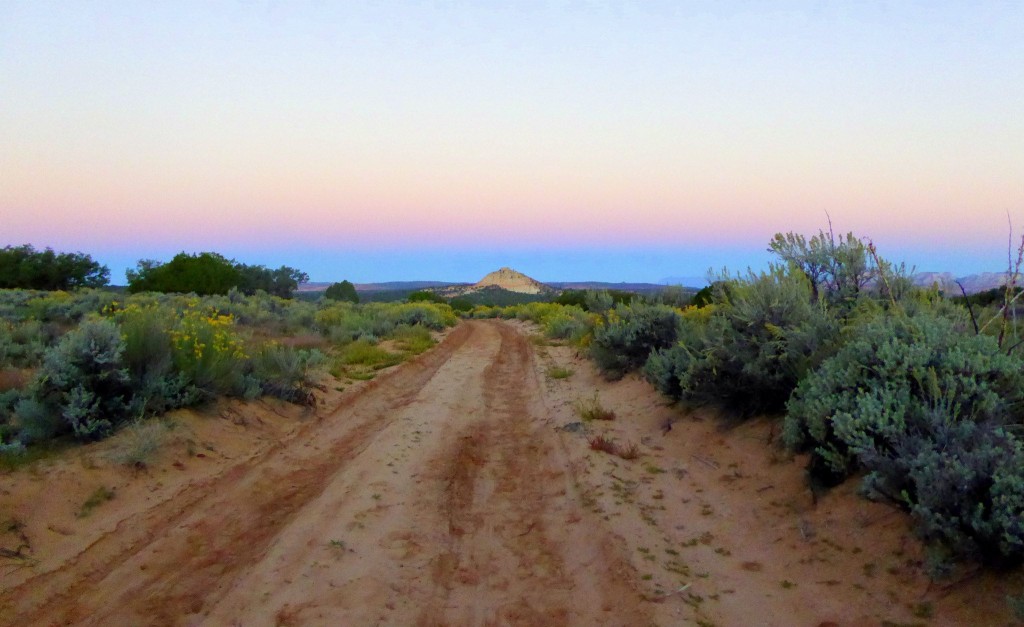
Relentless sandy track. (I’m not sure if this was taken in the 8-mile stretch I’m talking about–this may be the final stretch leading to camp–but it represents the terrain of those miles.) Photo by Simon Dodd
I felt like I was in Purgatory, with no salvation in sight. When my mood grew dark, I tried to lift it with dark humor by thinking of the absurdly freaky woman who does the Prancercise videos. It helped me lift my knees and “prance” through the sand.
But as the sun lowered in the sky and the temperatures cooled, and as a pink and orange hue of late-afternoon light colored the landscape, I felt better. I caught up with a woman who had started in the first wave, Lou Staples of the UK, who was in a funk and sick of the sand. We cheered each other up, and I cajoled her into running again. We got through Checkpoint 6, Mile 39, as night fell. The Corral Pink Sand Dunes lay ahead.
This would be my third visit to the dunes. The first time was the 2012 Grand to Grand, and the second time was on a family trip to Kanab over New Year’s Eve. I thought I knew these dunes. I thought I could efficiently get up and over them with unflagging resolve, because with the right attitude they are downright fun and awesome.
But, I had never done them in the dark and never followed this particular route. I was about to discover that the course changed this year, and the event organizers deliberately chose the hardest possible route, over as many steep dunes as they could.
Here is what the dunes look like in the daylight. We shot this video during our family trip, when my son, then 12, insisted on hiking with his snowboard so he could board down them. (That’s my boy!) Check out the slope of this dune. Then, imagine going UP a dune like that, and then doing it again and again and again. On a dark and starry night. When you already have 40 hard miles on your legs from that day, plus 58 miles from the prior two days. And you have a backpack. And your stomach is growling.
I had to go up about 20 of those motherf***ers.
So how do you run up a dune? You don’t. You crawl. But first, you find the route, which isn’t easy, because the course marking flags—which each have a tiny LED light on them—are so high up and far away that when you crane your neck up to spot them, you mistake them for a star. Then, with as much determination as you can muster, you start stepping and scrambling up the sand slope. This leads to comical slipping and flailing backwards, so more often than not you flop forward onto your hands. Then you start walking on all fours like a crab. You laugh, you cry, you pray to Jesus and cuss like a rapper.
The photographer was there in the daytime when Mickey, the frontrunner by hours, went through. He did not have gaiters on his shoes to keep out the sand, so he went barefoot while carrying his shoes. This is how it’s done:
I did really well, actually—for about the first 10 dunes. I embraced the challenge and relished the nighttime solitude, since no one was near me for at least a half mile in either direction. I congratulated myself on my progress, and I occasionally turned off my headlamp and paused to gaze at the stunning stars.
I recognized that what I was doing was extraordinary, and I probably would never experience anything like this again.
But after those first 10 or so, I started to grow impatient. This route was so much longer and harder than I remembered from 2012. I drank the last of my water and acknowledged that I was dehydrating due to my rapid breathing, but the next checkpoint with water was still some 5 miles away. Then, when I crawled to the top of a dune and stood up, I nearly passed out from dizzy lightheadedness. I had only one 100-calorie gel and about 200 calories in dehydrated soup mix to last until camp, which was nearly 13 miles away. I ate the last gel and wanted more.
My pace felt glacial, and the dunes seemed endless. Each time I climbed one thinking it would be the last, I’d reach the summit and then encounter the dark, massive shape of another one ahead. A growing sense of despair and a gnawing hunger made me feel increasingly helpless.
At that moment, I mentally turned the pages of a book I read this summer and felt grateful for reading that book, because in this survival mode, I clung to its example. The book is Endurance: Shackleton’s Incredible Voyageby Alfred Lansing, the century-old true saga of explorers surviving more than a year in the ice-bound Antarctic seas. They nearly starved and nearly froze. Again and again, they suffered setbacks and confronted hopeless circumstances. Yet, they endured.
I told myself I would not starve, I would not die from thirst, and as long as I continued to make progress—even if that progress could be measured in inches—I would, in fact, get there. I just had to avoid passing out. So I put all my thoughts and emotions on hold, and then I switched to auto-pilot to get the job done.
And I got it done.
Hell’s Garden and A New Moon
I made it to the checkpoint, satiated my thirst and, with the hot water provided at the checkpoint, I prepared my portion of dehydrated potato leek soup. It was heavenly. But I didn’t linger, because as soon as I stopped, I started to get chilled in the nighttime air. I still had 8 miles to go.
You might think that the dunes would be the ultimate challenge of the Long Stage, but you would be incorrect. After the dunes, in the 4.5 miles between Checkpoints 7 and 8 (Miles 45 – 49), we traverse a section that I nicknamed Hell’s Garden.
Hell’s Garden isn’t quite a forest, although it has lots of trees. It’s more like a thicket of the thorny bastard hybrids of piñon and sagebrush, along with the spawn of beavertail and prickly pear cacti.
No trail leads through Hell’s Garden, only hard-to-spot course ribbons dangling from branches, and to reach those ribbons, you have to plunge through branches and bushes full of spikes that poke your face and scratch your legs. Running is virtually impossible, because you must hopscotch over roots while ducking under branches.
But goddamn it, I was busting through with the utmost efficiency. I recalled that this was the spot in 2012 where I felt frozen in the dark, unable to spot the markers, and I had resorted to calming myself by talking out loud like a Minnesota granny (“Well for Pete’s sake, wouldya look at that?”). This time, however, I was like Thelma and Louise rolled into one. I was headed for Camp or Bust, and I was not going to take any more of this shit than I had to!
I made it through. There was only one problem. One stinging, burning, unbearable problem.
The fabric lining of my shorts had caused chaffing in the crease of my crotch, between my inner thigh and—well, you get the picture. I had ignored it for miles and used Aquaphor to lube it, to no avail. I felt a searing pain with each stride as the fabric rubbed away the skin.
In my starved, spent and half-crazed state, I did what only seemed logical, considering I was out there by myself in the dark: I pulled my shorts down and tried to take them off. But my shorts got hung up on the fabric gaiters of my shoes, so there was no easy way to pull them all the way off and then put them back on. Sitting bare-assed in the sand, I concluded that streaking from the waist down was more trouble than it was worth.
So I did the next best thing. I kept my shorts pulled down to mid-thigh, so the fabric was off the sore spot. It looked as if I had gone to the bathroom and forgot to pull up my pants. The waistband was stretchy enough to allow me to run that way.
Only the coyotes saw me, and they howled. I pulled up my shorts when I went through the final checkpoint, and then I pulled them down again and dug deep for the final 3 miles.
I ran. I don’t know how, but I found it in me to run rather than walk, through all that sand and on an empty stomach, ugly and dirty and with my flabby butt cheeks hanging out. The desire to reach camp propelled me forward as if nothing hurt and nothing else mattered.
And then, there it was—the site of the finish line banner, the sound of volunteers cheering and ringing cowbells. Obviously, I pulled up my shorts.
It was 1:10 a.m. It took me 15 hours, 10 minutes to finish the Long Stage. I was done and mostly numb, but a sense of profound satisfaction burned within.
I achieved the 9th fastest time out of 81 Stage 3 finishers and 17 dropouts.
Tess, the race director, enveloped me in a hug. Then Michele, Ken, Chantal and a handful of others hugged and high-fived too. I wanted to celebrate with them. But I needed to take care of my body, stat.
I found my recovery drink powder, mixed it with water and gulped it down—and almost instantly, I felt I would hurl. My body began shaking with nausea and chills. Wordlessly, I grabbed my sleeping bag and went into the med tent, which was empty except for a couple of cots.
I lay down on a cot, wrapped myself in my sleeping bag, and began to shake from head to toe while suppressing waves of nausea. I don’t know if I was suffering the onset of hypothermia or exhaustion or both, but I felt terribly ill.
The volunteer doctor came in and gave me an anti-nausea pill and kindly gave me his sleeping bag to put on top of me too. I passed out for a little while and then, half conscious, felt like I was floating and spasming while seeing visions of running through the sand at night.
The superhero doctor (who I couldn’t help noticing is pretty damn good looking, young and fit and blond) then helped me get a dehydrated backpacker meal out of my pack, and then he filled it with hot water, and I got a couple of bites down. I had maybe five bites and then passed out for another short while.
And then amazingly, at around 3 a.m., I felt surprisingly normal. I ate the rest of my meal, went to my tent, changed into my long underwear, got into my sleeping bag between my tentmates Mickey and Roberto, and passed out as if anesthetized.
The Heroes
I could have ended the story there. But the story of the Long Stage continued past noon the next day. When I woke up blinking and disoriented in the daylight of our tent, I heard more cheering and cowbells outside.
The day after the Long Stage is a scheduled recovery day, because it takes some participants more than 24 hours to complete it. I had a blissful full day to clean up and rest, regaining energy for the next two marathon-length stages.
A steady stream of hikers kept coming across the finish line. These brave souls had bivouacked at an earlier checkpoint, then tackled the sand dunes and Hell’s Garden in the heat of the mid-morning.
My tentmate Dan was one of the last ones in, because he hung back to help and hike with the back-of-the-packers.
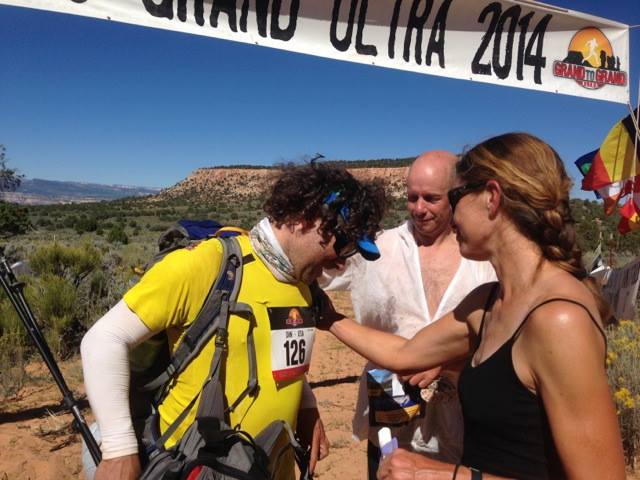
My tentmate Dan Owings finishing the long stage, being congratulated by me and our other tentmate Danny.
And finally, at 3:13 in the afternoon, more than 31 hours after starting, the very last person made her way in. It was Tina—short, stocky, steady Tina who came in last every stage but never, ever gave up.
The whole camp gathered at the finish line, and we began a tribal chant like a drumbeat of “Ti-na! Ti-na! Ti-na!” We got louder as she got closer, and when she crossed the finish line, every person erupted in cheers, and many wiped away tears, because this single person—this courageous and humble underdog—personified and magnified all our individual struggles and triumphs upon reaching the finish.
I felt as if I covered a lifetime and unveiled every facet of my personality in the 15 hours, 10 minutes I spent on the Long Stage. I also felt forever bonded with the other Grand to Grand participants who shared the journey and understood what it took to get there.
***
How about that: this race report turned into a trilogy. Click here to read Part 3.

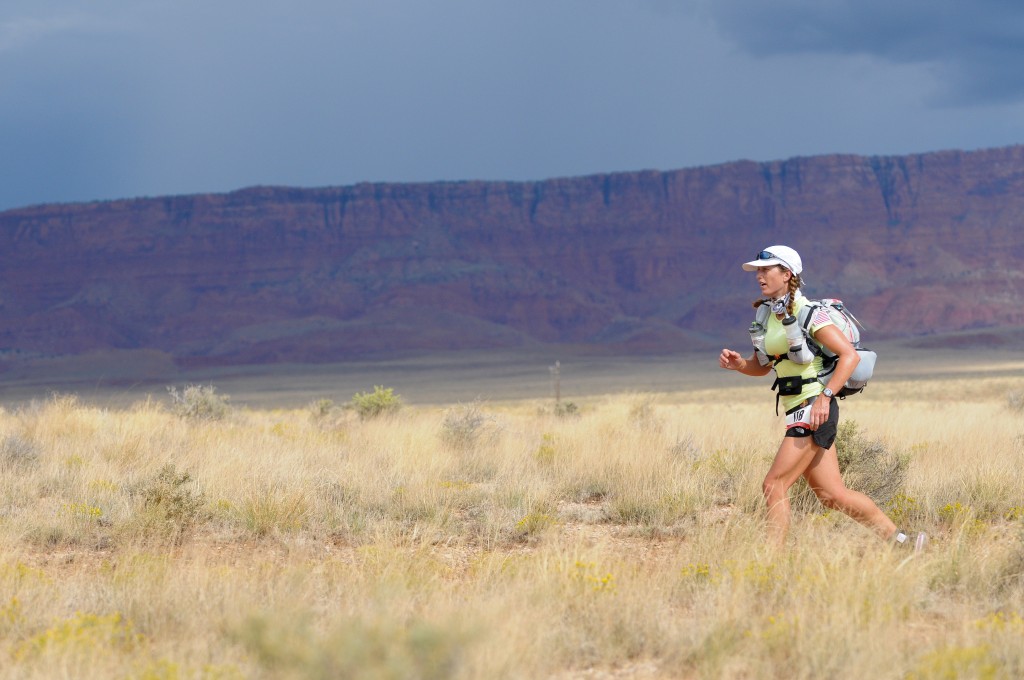
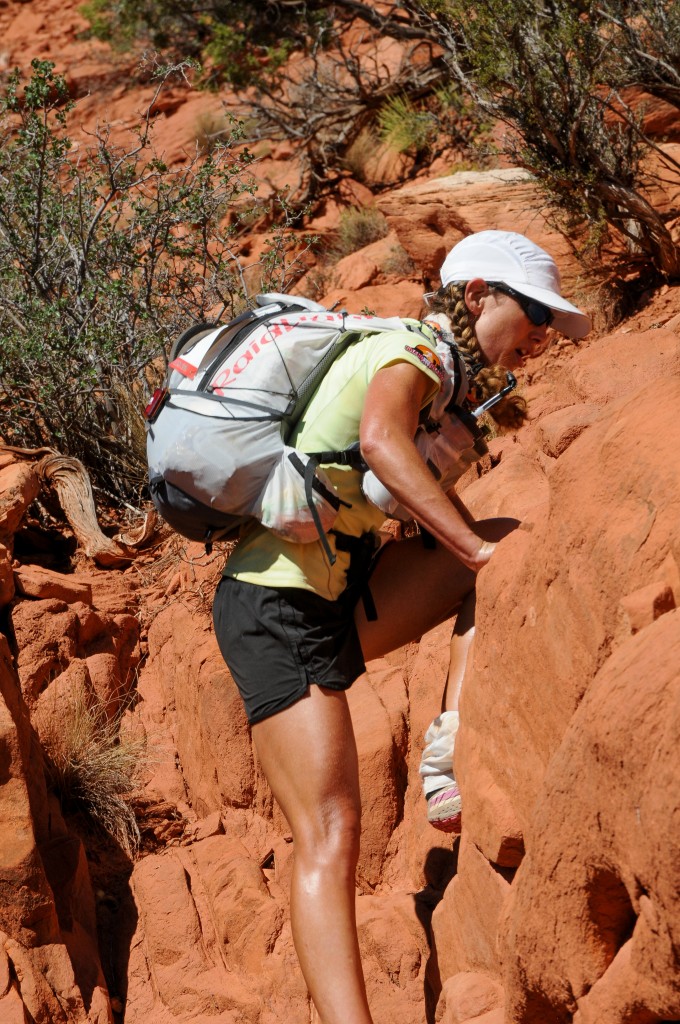
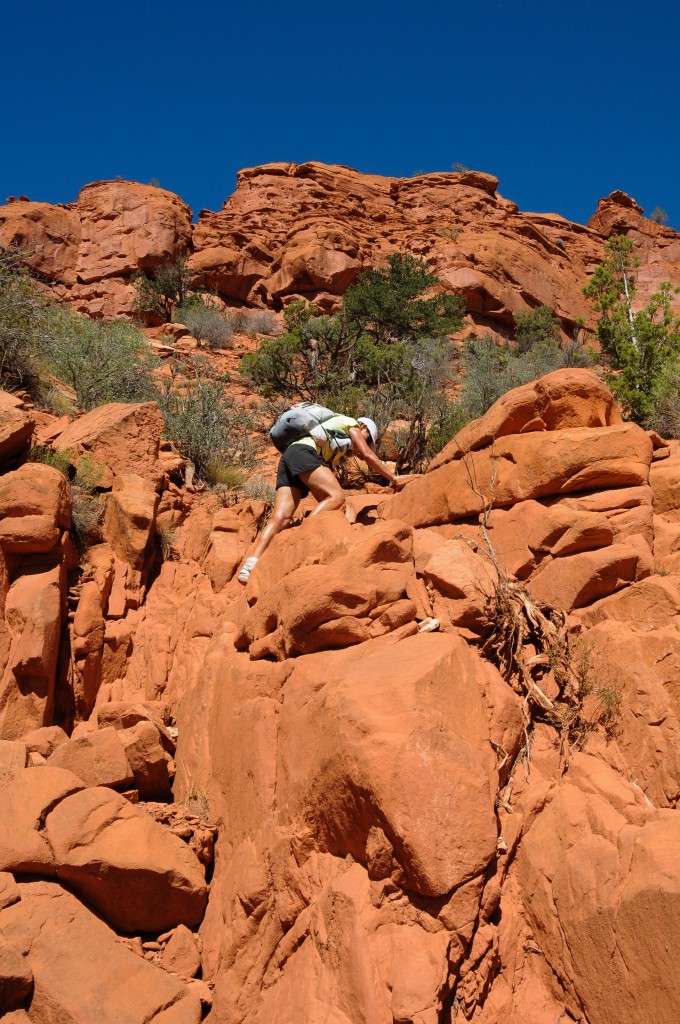
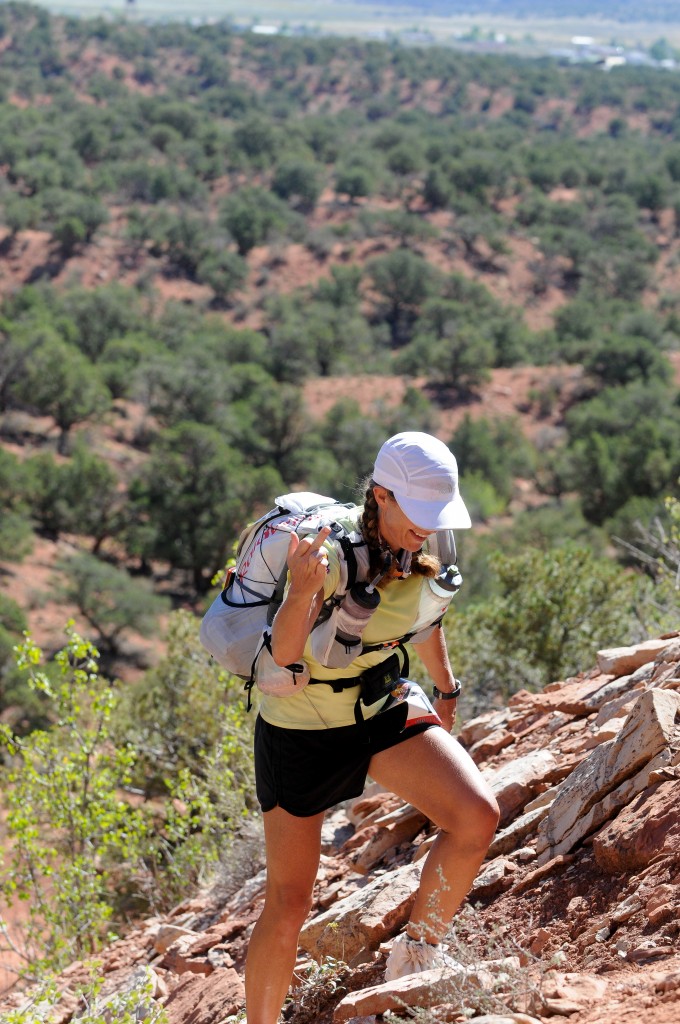
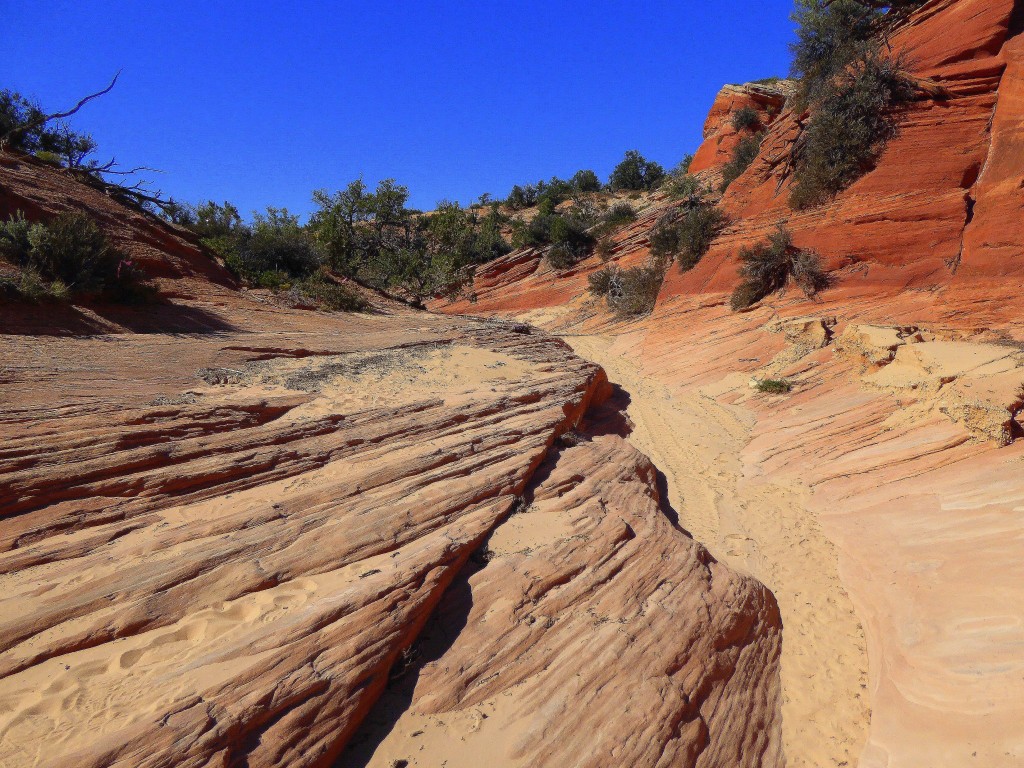
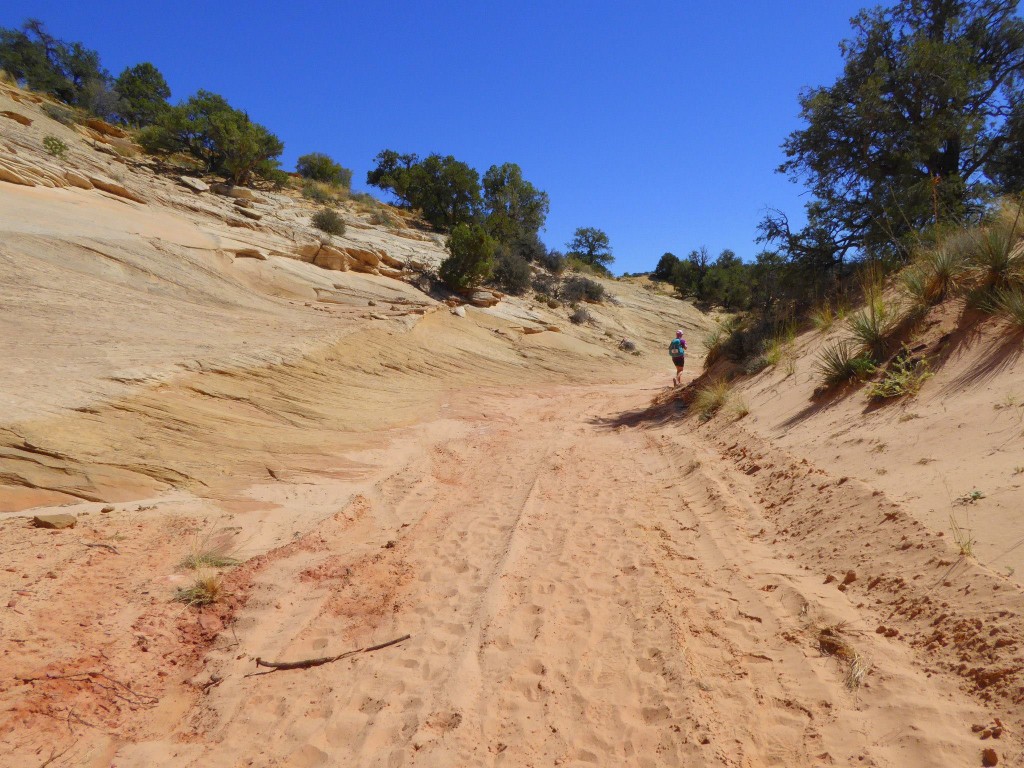
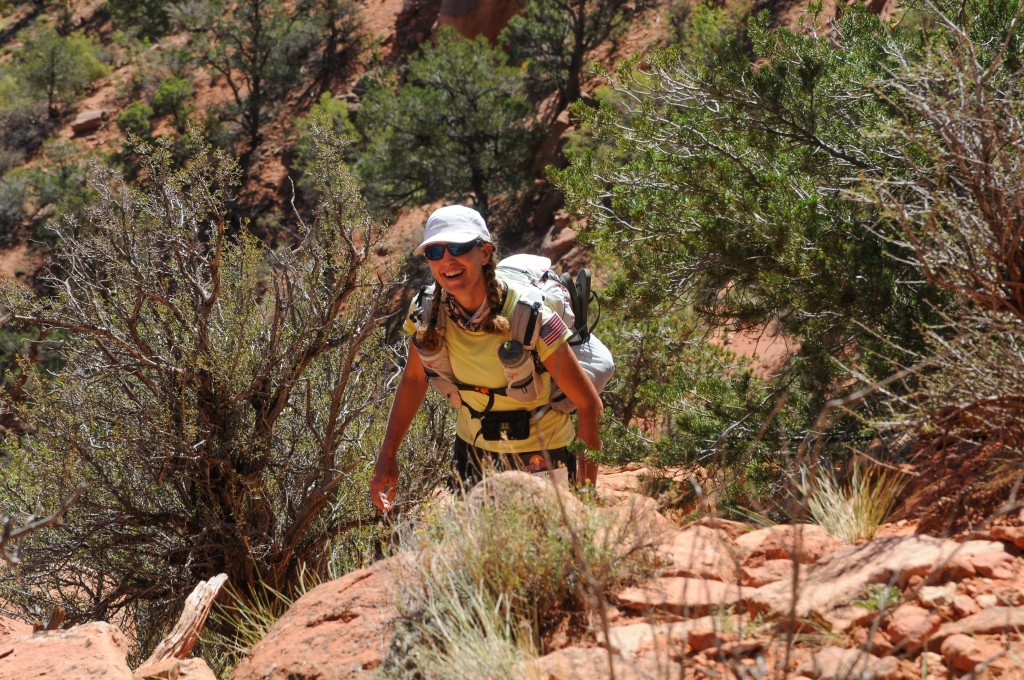
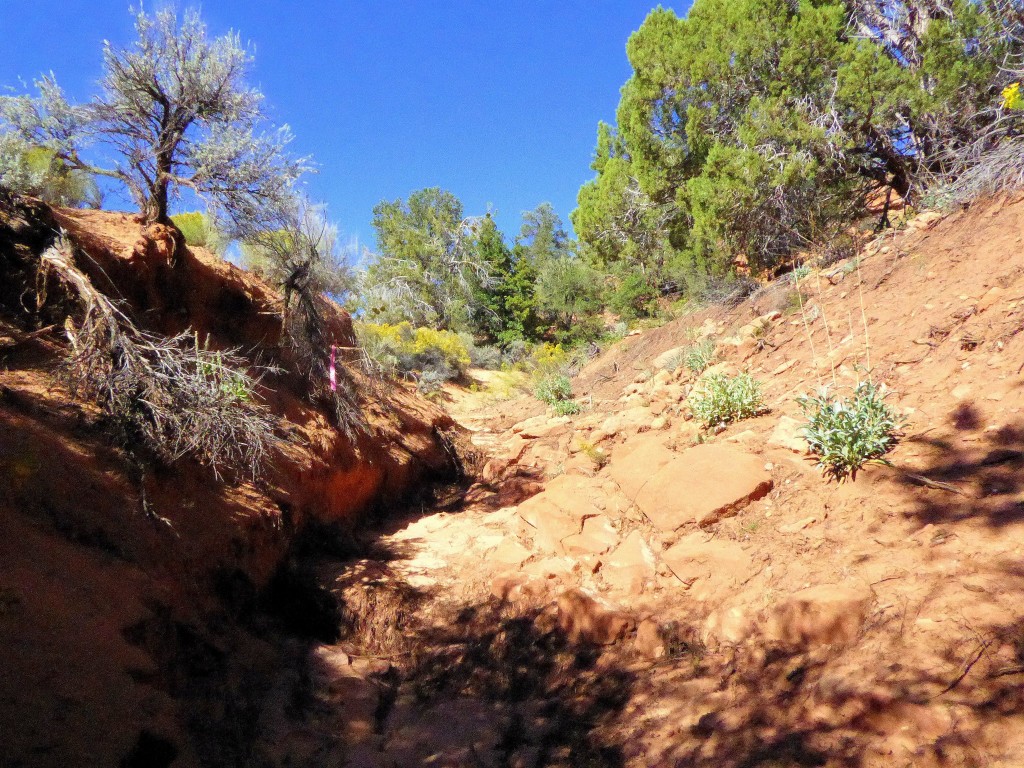
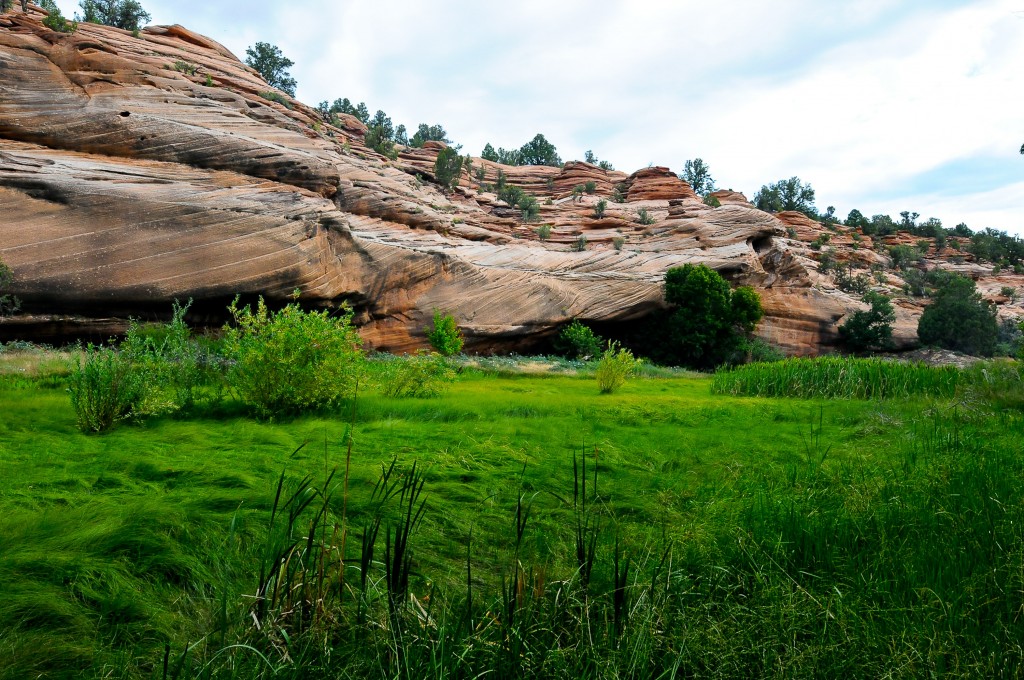
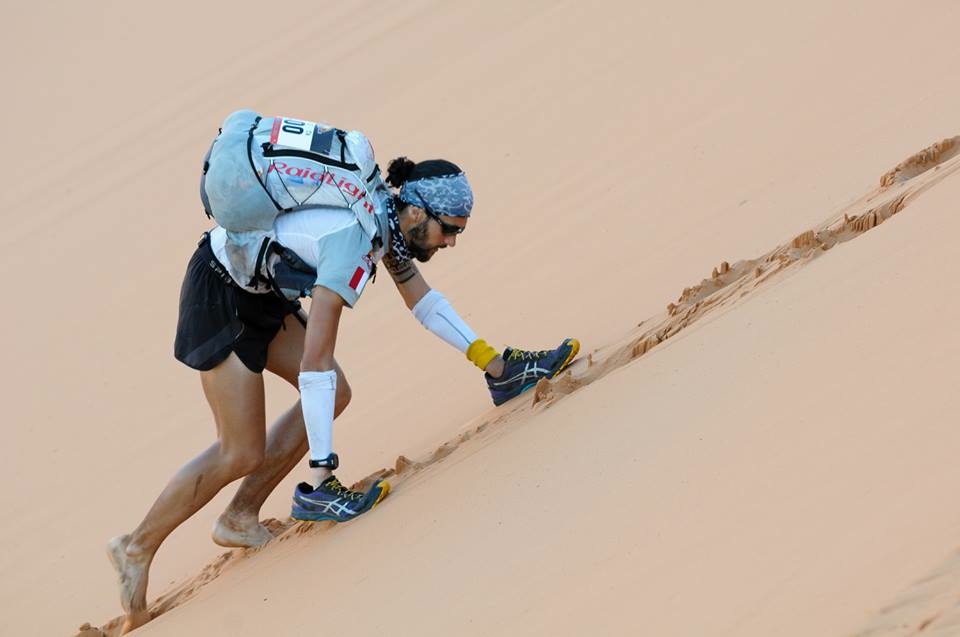
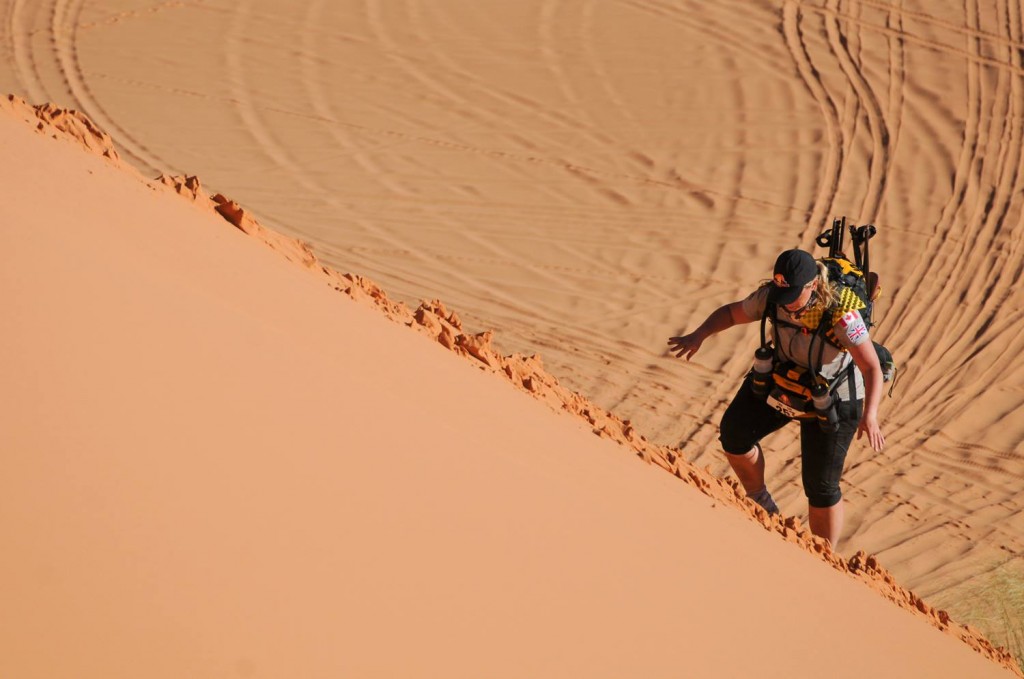
Thanks for capturing the day so well (and for letting me know what I should call you whenever I see you next at a race; “Hey sweeper!” – I love that he captured that shot of you making a rude gesture).
I think I had watched that video of your son boarding down that sand before, but it was only while reading this that I realized just how hard it must be to go up that and all the other dunes (and how hard he had to work to carry that thing up there). I can’t believe some entrepreneur hasn’t already set up a “Ski the Dunes” resort with a ski lift and lodge.
Trilogies are great!
Glad I saved part two for last–wonderful report, and the bit about dad was especially moving. Now that you’re a few weeks removed from the event, I hope that you re-read your own words and remind yourself of just how remarkable you are!
Just wow! You are amazing and I love reading about this awesome adventure!